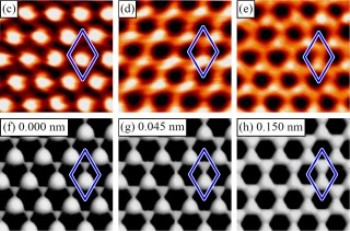The transition of graphite to graphene has always been a random process. Graphene, the single-layered structure comprising carbon atoms, was first isolated at the University of Manchester by stripping off the top layer from graphite with a scotch tape.
 Graphite to Graphene transition. Top: Experimental images. Bottom: Images produced from calculations (Credit: University of Arkansas)
Graphite to Graphene transition. Top: Experimental images. Bottom: Images produced from calculations (Credit: University of Arkansas)
Graphene is known to have virtually no resistance making it suitable for quantum computing and energy applications. However, since graphene is a relatively new material, there are still unknown aspects of its characteristics. Physicists Paul Thibado, Laurent Bellaiche, Yurong Yang and Peng Xu at the University of Arkansas have devised a technique to not only study but also control the graphite to graphene transition.
Conventional methods of graphene creation involve the usage of scanning tunneling microscopy on a stationary surface between the graphite and graphene layer. The new technique employs electrostatic manipulation scanning tunneling microscopy on a moving surface between graphene and graphite. This method facilitates the calculation of the force required to develop graphene, the distance between graphene and graphite layer and the total energy involved. Graphite offers resistance to the movement of electrons having mass. Electrons propagating through graphene are mass-less and face practically no resistance. The process by which electrons acquire mass is a concept of interest to particle physicists in their search for the hypothetical elementary particle, the Higgs boson. The boson is considered to be devoid of spin and electric charge with an unpredictable mass.
The movement of electron between a massive and mass-less state allows scientists to gain insight into the mass-related duality and the control achieved in this technique helps them employ graphene to further this understanding.
Source: http://www.uark.edu/